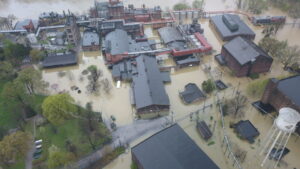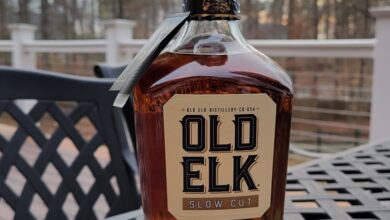Buffalo Trace Recovering From Major Flood
By Richard Thomas

(Credit: Sazerac)
Buffalo Trace Distillery draws in some 340,000 visitors annually which places it among the most visited distilleries in the world. For most of those visitors, the distillery’s location on the banks of the Kentucky River is one of its most bucolic features; indeed, the distillery itself figures prominently for kayakers and boaters enjoying the river.
Those of us who know the Kentucky River share that notion, but the sentiment is tempered by our memory of the river’s dark side. I spent my middle teens living on a farm on the Woodford-Franklin County line, and my most vivid memory of Frankfort from that time was watching it go underwater from the heights of the state cemetery. What is most shocking to me is that in every flood since, that 1989 disaster goes unmentioned. It should tell you a lot about Kentucky River flooding that references reach for the 1978 and 1997 floods instead.
The April 2025 Flood
The Bluegrass received between 8 and 9 inches of rain during the preceding days, which is double the amount the area receives during the entire course of April. By Monday the 7th, the draining creeks swelled the Kentucky and Ohio Rivers to near historic proportions. Frankfort, the state capital, reported a crest of 48.3 feet, the second highest recorded. The Kentucky River did not return to normal levels until Friday the 11th, and a week after the flood crested the distillery was reporting “signs of normalcy” at the distillery.

(Credit: Sazerac)
Floods of the Kentucky River are periodic and a fact of life for the lower, old part of Frankfort and those living downriver from there along its banks. Just a week before the flood, I was conducting interviews at the distillery and asked about flood precautions, and the cursory summary I was given at that time gave the impression that flood procedures are just part of doing business there. What happened earlier this month was anything but ordinary.
Although the reports from Buffalo Trace are encouraging, this has to be compared to a more typical flood, which is basically a hiccup to normal distillery operations. Assessment of what the damage might have been to bourbon barrels on lower rickhouse floors did not begin until Thursday the 10th. Clean-up and repair efforts have involved hundreds of people, and even by the middle of this week the removal of debris was not quite complete. Power was out for more than a week, although it has been restored to key areas. The visitor program reopened, but not in the visitor center, which has experience substantial water damage. Instead it’s in another building using pop-up resources.
“Thanks to the tireless efforts of our contractors and dedicated teams, we’ve made tremendous progress in the Distillery’s flood recovery plan. While there’s still work to be done, the resilience and determination demonstrated this past week is truly inspiring,” said Jake Wenz, Sazerac & Buffalo Trace Distillery CEO and President. “Each day significant progress is made allowing the Distillery to return to normal operations and I am optimistic that, with this same spirit, we’ll be operating normally soon. We want to thank all of the contractors, our leaders, and our team members for their hard work.”

Past Flooding
Folks at Buffalo Trace point to the 1978 flood as the worst disaster the distillery has suffered since it was burned down in a lighting strike in 1882. Some buildings in the distillery bear water level markers for this all-time high flood, which reached 48.5 feet. Harlen Wheatley told me it was especially devastating because the water piled up against the upriver dam very swiftly, forcing the authorities to open the floodgates without the customary warnings. Instead of having a day or more to prepare, as is usually the case, the distillery had just a few hours.
Geography helps make the Kentucky River especially treacherous. Upriver from Frankfort is a 100-mile long feature called the Palisades. On one side of the river is an almost continuous set of high limestone cliffs, while the other is marked by a steep, rugged and almost as high set of hillsides. When the flooding passes through this length run of the river, it has almost nowhere to go and channels out of the Palisades. Events that are relatively mild on the eastern end of the Palisades can become quite severe once they’ve left that area, before moderating again north and downriver of Frankfort. Thus, the 2021 sight of a riverfront boathouse swept into Frankfort’s Singing Bridge became the signature of an otherwise unremarkable flood of the Kentucky; a similar event in the 2025 disaster became a footnote, which underscores how much worse this flood was.


